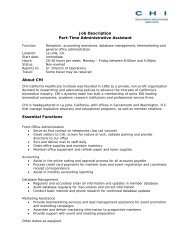California Biomedical Industry - California Healthcare Institute
California Biomedical Industry - California Healthcare Institute
California Biomedical Industry - California Healthcare Institute
You also want an ePaper? Increase the reach of your titles
YUMPU automatically turns print PDFs into web optimized ePapers that Google loves.
Government funding fueling innovationin <strong>California</strong><strong>Biomedical</strong> research theworld over is funded bycorporations, governmentand charitable foundations.Generally, industry researchis devoted to productdevelopment; governmentfunding supports basicresearch; and charitablefoundations strive toadvance basic sciencetoward therapies for specificdiseases.The U.S. government pays for anestimated 36 percent of the country’smedical research. Conducted primarilyby university and independent researchlabs, government-supported researchoften leads to important discoveriesthat add to basic understanding ofthe natural world. University-drivendiscoveries also often are key toidentifying promising targets fortreating or curing diseases, unravelingmysteries of how diseases or the humanbody work, or inspiring new approachesto difficult problems.Critics of government funding ofbiomedical research contend that suchresearch is often too basic, and doesnot contribute an adequate return oninvestment to taxpayers. Innovatorsfrom all industries would disagree.As the gaps in the body of scientificknowledge are filled in, incrementalfindings combine to illuminate andclarify the workings of the mostcomplex systems, enabling scientistsand clinicians to suggest preventivemeasures and offer treatments or cureswhere none were previously available.An advantage of government fundedresearch is that the results are madepublic. Scientists, researchers andclinicians build on one another’sfindings and learn from one another’smistakes.Because government grantspredominantly go to university faculty,post-doctoral fellows and graduatestudents, they ensure a continuingopportunity for young researchers tocomplete their training and pursue theirpassions — experience that serves asthe foundation for long and productivecareers.Studies show that governmentinvestment in research leads tothe formation and success of newcompanies. Startup firms create jobs,produce new therapeutic products,and pay taxes and salaries. Withoutgovernment funding, the <strong>California</strong>biomedical industry would not bethe innovation powerhouse that it istoday — nor would the state have theinfrastructure, capacity and potentialit has to continue to lead the world inimproving human health and quality oflife.Grants from the National<strong>Institute</strong>s of HealthBeginning in the 1950s, the National<strong>Institute</strong>s of Health (NIH) has beena major source of grant funding touniversities and other researchers.Comprised of 27 institutes and centers,the NIH covers the full range of humanhealth issues. Its specialties includeoncology, cardiology, respiratoryconditions, mental health, allergies,infectious diseases, aging and diabetesamong others.By encouraging cross-functionalresearch teams, the NIH has broughttogether experts from the fields ofmedicine, engineering, math andinformation technology to devise newmeans for preventing, diagnosing,treating and curing disease.Beyond improving the understandingof human biology and the pathogenesisof disease, NIH grants haveempowered young scientists, engineers,mathematicians and others to buildsuccessful careers in academia and in<strong>California</strong> <strong>Biomedical</strong> <strong>Industry</strong> 2011 Report | 67






